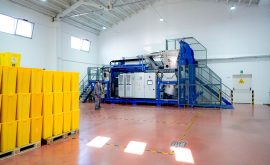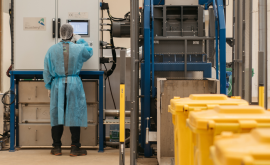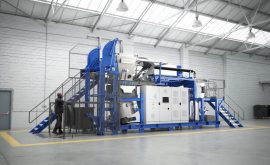A World Tour of Medical Waste Terminology
Do you speak “medical waste”?

Just like in any specialised field or professional sector, the world of medical waste management comes with its own language and specific terminology. However, these terms can vary significantly depending on the country, continent, language, or culture. This is especially true for infectious medical waste—a subcategory of medical waste treated by Ecosteryl machines. Despite differences in terminology, the classification principles for infectious medical waste are broadly similar: they all refer to healthcare-generated waste that poses a biological contamination risk (e.g. blood, dressings, needles, etc.).
Clinical waste, healthcare waste, potentially infectious waste, DASRI, infectious waste, biomedical waste, Infektiöser Abfall… It’s not always easy to navigate. From Brussels to Bogotá, from New Delhi to Melbourne, there’s a local flavour in the language of health and medical waste.
The terms used to describe medical waste have evolved over time and vary from region to region and language to language. These changes often reflect local public health priorities and waste management concerns. Often, these terms are officially and legally defined (by laws, regulations, directives, codes, etc.) by local Ministries of Public Health or Environment.
In practice, terminology is shaped by local culture and practices. For example, in France, the acronym DASRI (Infectious Risk Healthcare Activity Waste) emphasises concerns around preventing hospital-acquired infections.
In German, the language tends to favour highly precise terms and subcategories, reflecting a structured and rigorous approach to waste management.
English terms like “medical waste” or “healthcare waste” are more pragmatic and descriptive, making them easier to understand and use in an international context.
Latin languages (French, Spanish, Italian) tend to use terminology directly linked to the medical field, such as “déchets biomédicaux”, “residuos sanitarios”, or “rifiuti sanitari”. These terms highlight the origin of the waste and its connection to healthcare activities.
Terminology and classification can also be adapted to fit local needs and contexts. For instance, in developing countries, simplified terms may be used to ease the implementation of waste management practices.
While we won’t attempt to list terms from all 195 countries, here are a few examples from different parts of the world:
France:
• DASRI (Déchets d’Activités de Soins à Risques Infectieux)
• Sometimes referred to as “déchets médicaux à risques” (medical waste with risk)
USA:
• RMW (Regulated Medical Waste)
• Biohazardous waste
• Infectious waste
Spain:
• Residuos sanitarios
• Residuos sanitarios infecciosos et Residuos biosanitarios
Italy:
• Rifiuti sanitari
• Rifiuti sanitari infetti
United Kingdom :
• Clinical waste
• Infectious healthcare waste
Portugal :
• “Resíduos de Serviços de Saúde” (RSS)
• Resíduos Hospitalares
• Resíduos hospitalares de risco biológico
European Union (framework directive) :
• Healthcare Waste (HCW)
• Infectious waste
Africa:
• DASRI is commonly used in Francophone Africa
• “Déchets biomédicaux” is a broader term found across many countries
• In Anglophone Africa, common terms include: Healthcare Waste (HCW), Medical Waste, Infectious Healthcare Waste (IHW), Biomedical Waste (BMW)
South America :
• Residuos sanitarios
• Residuos peligrosos infecciosos / Residuos sanitarios infecciosos
Canada :
• “Déchets biomédicaux” (in French)
• Biomedical Waste (BMW) (in English)
• Infectious Waste is also used when specifying biological risk
Germany:
• Krankenhausabfälle
• Infektiöser Abfall
Switzerland :
• Déchets médicaux spéciaux or DASRI (similar to French usage)
Australia and New Zealand:
• Clinical Waste
• Infectious Waste
China:
• 医疗废物 (Yīliáo fèiwù) – Medical waste
• 感染性废物 (Gǎnrǎn xìng fèiwù) – Infectious waste
Japan:
• 医療廃棄物 (Iryō haikibutsu) – Medical Waste
• 感染性廃棄物 (Kansen-sei haikibutsu) – Infectious waste
India:
• Biomedical Waste (BMW)
• Infectious Waste
Le monde Arabe :
• نفايات طبية – Medical waste
• نفايات طبية حاملة خطر العدوى – Infectious risk medical waste
Towards harmonisation with international organisations
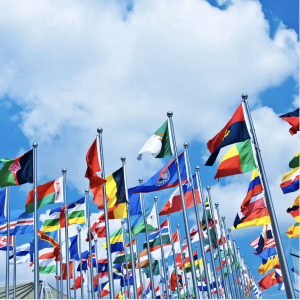
International bodies like the World Health Organization (WHO) play a crucial role in harmonising terminology and best practices worldwide. The use of standardised terms such as healthcare waste helps build shared understanding and facilitates global cooperation.
The WHO defines medical waste as “all waste generated by healthcare activities.” This includes a wide range of materials: needles, dressings, expired medications, chemicals, biological waste (human tissues, organs, etc.), and sharp objects.
A universal pictogram
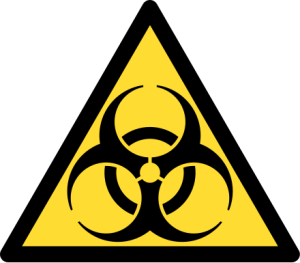 Beyond written language, there’s also the visual language. Here, the picture is simpler and more consistent. The pictogram for infectious medical waste is universally recognised among professionals. Bins designated for potentially infectious medical waste—and the containers used to store them—are typically coloured yellow or red, depending on the region.
Beyond written language, there’s also the visual language. Here, the picture is simpler and more consistent. The pictogram for infectious medical waste is universally recognised among professionals. Bins designated for potentially infectious medical waste—and the containers used to store them—are typically coloured yellow or red, depending on the region.
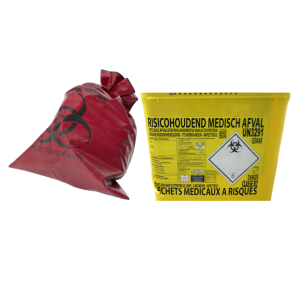
Optimal disinfection: A global imperative
In the end, no matter what terminology is used to describe medical waste, the key objective is to ensure complete disinfection to protect public health and the environment on a global scale. The challenge is indeed universal—and spoken in every language!
Want to learn more about Ecosteryl’s medical waste treatment solutions?
Contact our team: sales@ecosteryl.com

